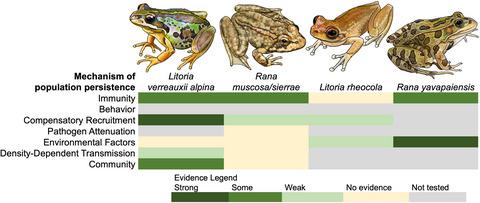当前位置:
X-MOL 学术
›
Ecol. Lett.
›
论文详情
Our official English website, www.x-mol.net, welcomes your feedback! (Note: you will need to create a separate account there.)
Mechanisms underlying host persistence following amphibian disease emergence determine appropriate management strategies
Ecology Letters ( IF 8.8 ) Pub Date : 2020-10-16 , DOI: 10.1111/ele.13621 Laura A. Brannelly 1 , Hamish I. McCallum 2 , Laura F. Grogan 2, 3 , Cheryl J. Briggs 4 , Maria P. Ribas 3, 5 , Matthijs Hollanders 3 , Thais Sasso 2 , Mariel Familiar López 6 , David A. Newell 3 , Auston M. Kilpatrick 7
Ecology Letters ( IF 8.8 ) Pub Date : 2020-10-16 , DOI: 10.1111/ele.13621 Laura A. Brannelly 1 , Hamish I. McCallum 2 , Laura F. Grogan 2, 3 , Cheryl J. Briggs 4 , Maria P. Ribas 3, 5 , Matthijs Hollanders 3 , Thais Sasso 2 , Mariel Familiar López 6 , David A. Newell 3 , Auston M. Kilpatrick 7
Affiliation

|
Emerging infectious diseases have caused many species declines, changes in communities and even extinctions. There are also many species that persist following devastating declines due to disease. The broad mechanisms that enable host persistence following declines include evolution of resistance or tolerance, changes in immunity and behaviour, compensatory recruitment, pathogen attenuation, environmental refugia, density‐dependent transmission and changes in community composition. Here we examine the case of chytridiomycosis, the most important wildlife disease of the past century. We review the full breadth of mechanisms allowing host persistence, and synthesise research on host, pathogen, environmental and community factors driving persistence following chytridiomycosis‐related declines and overview the current evidence and the information required to support each mechanism. We found that for most species the mechanisms facilitating persistence have not been identified. We illustrate how the mechanisms that drive long‐term host population dynamics determine the most effective conservation management strategies. Therefore, understanding mechanisms of host persistence is important because many species continue to be threatened by disease, some of which will require intervention. The conceptual framework we describe is broadly applicable to other novel disease systems.
中文翻译:

两栖动物疾病出现后宿主持续存在的潜在机制决定了适当的管理策略
新兴传染病已导致许多物种减少,群落变化甚至灭绝。在由于疾病造成的毁灭性破坏之后,还有许多物种继续存在。导致宿主持久性下降的广泛机制包括耐药性或耐受性的演变,免疫力和行为的变化,代偿性补充,病原体衰减,环境避难所,密度依赖性传播和群落组成的变化。在这里,我们检查了壶菌病,这是上个世纪最重要的野生动物疾病。我们回顾了可实现宿主持久性的各种机制,并对宿主,病原体,与壶菌病相关的衰退后持续存在的环境和社区因素,并概述了目前的证据以及支持每种机制所需的信息。我们发现,对于大多数物种而言,促进持久性的机制尚未确定。我们说明了驱动长期寄主种群动态的机制如何确定最有效的保护管理策略。因此,了解宿主持久性的机制很重要,因为许多物种继续受到疾病的威胁,其中一些将需要干预。我们描述的概念框架广泛适用于其他新型疾病系统。我们说明了驱动长期寄主种群动态的机制如何确定最有效的保护管理策略。因此,了解宿主持久性的机制很重要,因为许多物种继续受到疾病的威胁,其中一些将需要干预。我们描述的概念框架广泛适用于其他新型疾病系统。我们说明了驱动长期寄主种群动态的机制如何确定最有效的保护管理策略。因此,了解宿主持久性的机制很重要,因为许多物种继续受到疾病的威胁,其中一些将需要干预。我们描述的概念框架广泛适用于其他新型疾病系统。
更新日期:2020-12-12
中文翻译:

两栖动物疾病出现后宿主持续存在的潜在机制决定了适当的管理策略
新兴传染病已导致许多物种减少,群落变化甚至灭绝。在由于疾病造成的毁灭性破坏之后,还有许多物种继续存在。导致宿主持久性下降的广泛机制包括耐药性或耐受性的演变,免疫力和行为的变化,代偿性补充,病原体衰减,环境避难所,密度依赖性传播和群落组成的变化。在这里,我们检查了壶菌病,这是上个世纪最重要的野生动物疾病。我们回顾了可实现宿主持久性的各种机制,并对宿主,病原体,与壶菌病相关的衰退后持续存在的环境和社区因素,并概述了目前的证据以及支持每种机制所需的信息。我们发现,对于大多数物种而言,促进持久性的机制尚未确定。我们说明了驱动长期寄主种群动态的机制如何确定最有效的保护管理策略。因此,了解宿主持久性的机制很重要,因为许多物种继续受到疾病的威胁,其中一些将需要干预。我们描述的概念框架广泛适用于其他新型疾病系统。我们说明了驱动长期寄主种群动态的机制如何确定最有效的保护管理策略。因此,了解宿主持久性的机制很重要,因为许多物种继续受到疾病的威胁,其中一些将需要干预。我们描述的概念框架广泛适用于其他新型疾病系统。我们说明了驱动长期寄主种群动态的机制如何确定最有效的保护管理策略。因此,了解宿主持久性的机制很重要,因为许多物种继续受到疾病的威胁,其中一些将需要干预。我们描述的概念框架广泛适用于其他新型疾病系统。


























 京公网安备 11010802027423号
京公网安备 11010802027423号